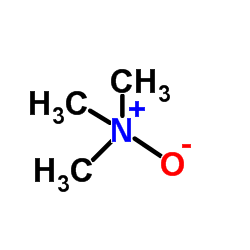Trimethylamine oxide

Trimethylamine oxide structure
|
Common Name | Trimethylamine oxide | ||
|---|---|---|---|---|
| CAS Number | 1184-78-7 | Molecular Weight | 75.110 | |
| Density | 0.9301 (rough estimate) | Boiling Point | 133.8°C (rough estimate) | |
| Molecular Formula | C3H9NO | Melting Point | 220-222ºC(lit.) | |
| MSDS | Chinese USA | Flash Point | N/A | |
| Symbol |

GHS07 |
Signal Word | Warning | |
|
HMDB: a knowledgebase for the human metabolome.
Nucleic Acids Res. 37(Database issue) , D603-10, (2009) The Human Metabolome Database (HMDB, http://www.hmdb.ca) is a richly annotated resource that is designed to address the broad needs of biochemists, clinical chemists, physicians, medical geneticists, nutritionists and members of the metabolomics community. Si... |
|
|
Prediction of skeletal muscle and fat mass in patients with advanced cancer using a metabolomic approach.
J. Nutr. 142(1) , 14-21, (2012) Urine and plasma metabolites originate from endogenous metabolic pathways in different organs and exogenous sources (diet). Urine and plasma were obtained from advanced cancer patients and investigated to determine if variations in lean and fat mass, dietary ... |
|
|
Gender-related and age-related urinalysis of healthy subjects by NMR-based metabonomics.
NMR Biomed. 21(3) , 195-207, (2008) NMR-based metabonomic analysis is a well-established approach to characterizing healthy and diseased states. The aim of this study was to investigate inter-individual variability in the metabolic urinary profile of a healthy Greek population, not subjected to... |
|
|
Improving the serum D-xylose test for the identification of patients with small intestinal malabsorption.
J. Clin. Gastroenterol. 33(1) , 36-40, (2001) D-Xylose absorption testing is a simple, low-cost method of screening for small intestinal malabsorption. The optimum method to measure D-xylose absorption (serum vs. urine testing) is uncertain.We present a method of improving the accuracy of D-xylose testin... |
|
|
Trimethylamine-N-oxide: a carnitine-derived metabolite that prolongs the hypertensive effect of angiotensin II in rats.
Can. J. Cardiol. 30(12) , 1700-5, (2014) Recent evidence suggests that an elevated plasma trimethylamine N-oxide (TMAO) level is associated with an increased risk of adverse cardiovascular events in humans; however, the mechanism is not clear. The aims of this study were to establish the plasma TMAO... |
|
|
Fenofibrate causes elevation of betaine excretion but not excretion of other osmolytes by healthy adults.
J. Clin. Lipidol. 8(4) , 433-40, (2014) Cross-sectional data suggest that bezafibrate increases betaine excretion in dyslipidemic patients.We aimed to demonstrate that fenofibrate induces increased betaine excretion in normal subjects and explore whether other 1-carbon metabolites and osmolytes are... |
|
|
SPE-NMR metabolite sub-profiling of urine.
Anal. Bioanal. Chem 404(8) , 2349-61, (2012) NMR-based metabolite profiling of urine is a fast and reproducible method for detection of numerous metabolites with diverse chemical properties. However, signal overlap in the (1)H NMR profiles of human urine may hamper quantification and identification of m... |
|
|
750 MHz 1H and 1H-13C NMR spectroscopy of human blood plasma.
Anal. Chem. 67(5) , 793-811, (1995) High-resolution 750 MHz 1H NMR spectra of control human blood plasma have been measured and assigned by the concerted use of a range of spin-echo, two-dimensional J-resolved, and homonuclear and heteronuclear (1H-13C) correlation methods. The increased spectr... |
|
|
Extreme urinary betaine losses in type 2 diabetes combined with bezafibrate treatment are associated with losses of dimethylglycine and choline but not with increased losses of other osmolytes.
Cardiovasc. Drugs Ther. 28(5) , 459-68, (2014) Betaine deficiency is a probable cardiovascular risk factor and a cause of elevated homocysteine. Urinary betaine excretion is increased by fibrate treatment, and is also often elevated in diabetes. Does fibrate further increase betaine excretion in diabetes,... |
|
|
Detection of autosomal dominant polycystic kidney disease by NMR spectroscopic fingerprinting of urine.
Kidney Int. 79(11) , 1244-53, (2011) Autosomal dominant polycystic kidney disease (ADPKD) is a frequent cause of kidney failure; however, urinary biomarkers for the disease are lacking. In a step towards identifying such markers, we used multidimensional-multinuclear nuclear magnetic resonance (... |